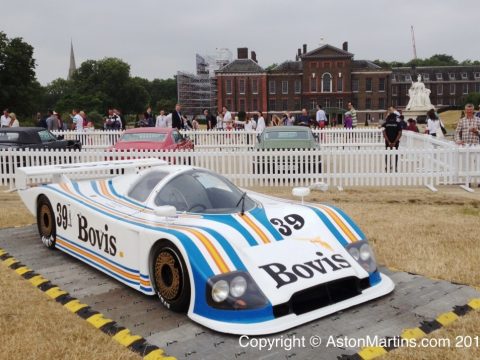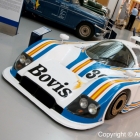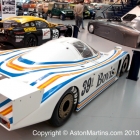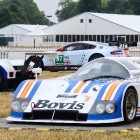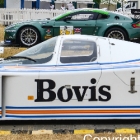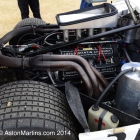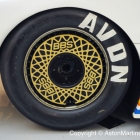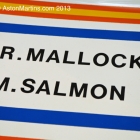Over the winter of 1982/3, with some money from Pace Petroleum, owned by Victor Gauntlett, development of their chassis, /004 continued under Richard Williams and Ray Mallock. The car received a new ‘evolution’ body with the advantages of being both lighter in weight and 10% less aerodynamic drag than the original, but also offered three times the downforce too. Although the winter development had produced a drop in weight from 1074 kg to 987 kg, it was still heavier that the team had wished for.
The first competitive outing of the 1983 season was at the Silverstone 1000 Km during May where /004 achieved 7th place from 15th on the grid in the hands of Mallock and Salmon. The following month again saw the Downe Nimrod entered into the 24 Hour race at Le Mans where the driving team were Mallock, Salmon and Steve Earle. During qualifying, the car achieved a top speed of 213 mph along the Mulsanne Straight, 12 mph greater than had been achieved during the previous years race and 11 seconds a lap quicker. During the race itself, the car both gained and lost places until shortly after 9 of the Sunday morning, a conrod broke and the car was retired.
Another two 1000km races at Spa and Brands Hatch followed with 004 being driven by the established pairing of Mallock and Salmon but the car failed to finish either race due to engine and transmission problems. The last race of the 1983 season was a 45 minute sprint in the Thundersports series at Brands Hatch where the 004 car came in fourth.
The Downe team equalled the 1982 achievement of coming third in the 1983 World Endurance Championship. The 1984 season saw the competitive debut of a 5th Nimrod, /005, originally purchased by Peter Livanos in 1982 then sold it to Victor Gauntlett who then sold it on to John Cooper.
The Downe team with /004 made their one and only race appearance in the USA during the 1984 Daytona 24 Hours. The race was also notable for being the only time that three Nimrods had competed against each other as the ex NRA car /002 had been entered by Jack Miller and /005, painted British Racing Green, had been entered by John Cooper. Following 24 hours of racing, the /002 car had retired, the /004 Downe car of Mallock, Olson and Sheldon finished 16th and on its debut and /005 in the hand of Cooper, Bob Evans and Paul Smith came in 7th after starting 26th on the grid.
Following Daytona, John Cooper parted with /005, which returned to Peter Livanos who was the original owner of the car back in 1982. The car was then entrusted to the established Downe Nimrod team and also received the Evolution bodywork with Bovis livery although this was in made from lighter Kevlar with quick release too. Weight was further reduced with the fitting of titanium springs. Another modification to /005 to achieve more power and lower fuel consumption was the fitting of twin-turbos, something that AML had already done with the Lagonda turbo and the Bulldog.
The first appearance of the now two Nimrod Downe team was at the 1984 Silverstone 1000 Km in May but neither car finished the race. The turbocharged /005 of Mallock and Olsen was withdrawn with an oil leak and /004 of Richard Attwood, Sheldon and Salmon dropped a valve. Following this race, /005 returned to normally aspirated form.
The 1984 Le Man 24 Hour race had special significance for Aston Martin since it had been 25 years since the famous 1959 win with the DBR1. Chassis /005 was given a Tickford engine especially built for qualifying and in the hands of Mallock, Olsen and Attwood achieved 10th on the grid. The heavier /004 of Salmon, Attwood and Sheldon was down in 30th place. All was going well until after 9 in the evening when the /004 car whilst in the hands of John Sheldon suffered a tyre blowout at a speed in excess of 200 mph at the Mulsanne kink. The car smashed into the Armco and disintegrated and burst into flames as the tank was almost full. John Sheldon was injured and badly burned although he was able to get out of the car and walk away. A track marshal wasn’t so fortunate and was killed. Close behind the scene of the accident was Dr Jonathan Palmer in a Porsche who was able to brake and avoid the debris, followed by Drake Olsen in /005. Olsen, very close behind the Porsche, tried to avoid hitting it by swerving, got onto the loose material at the edge of the track and also spun off into the Armco. The Downe team sadly withdrew from racing, Peter Livanos repaired /005 and took it back to the US although in no longer competed. Although /004 was effectively destroyed, Lord Downe was able to rebuild the car in 1988 from a new tub and spares from the 1984 season. After working in the Downe team, Ray Mallock and Richard Williams carried on endurance racing with Ecurie Ecosse in the C2 class for the next few years until such time as Aston Martin returned to endurance sportscar racing with the AMR1 at the end of the 1980s.



